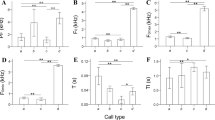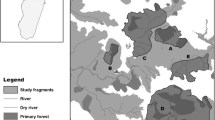Abstract
Adult male Nilgiri langurs (Presbytis johnii) utter loud call bouts consisting of one or more phrases. Phrases are made up of several units showing similar or different structural features. The units involved differ with respect to not only their physical structure but also their overall utilization: three vocal patterns are uttered exclusively by mature males living in bisexual groups or all-male bands and, in addition to being part of loud call bouts, are given during encounters with terrestrial predators; two vocal patterns are uttered by males and females, again not just as constituents of loud calls; and one vocal pattern is given exclusively by mature males living in bisexual groups. Within a given bout, phrases differ not only with respect to their composition but also in their temporal organization. In addition to the acoustic components, loud calls are regularly accompanied by stereotyped motoric displays. The motoric and acoustic components of loud call displays appear independently of each other and at different times during ontogeny. The development of the display is characterized by combination of units with different structural features and synchronization of vocal and motoric components. Although more evidence is needed, our observations suggest that the development of loud call displays coincides with the aquisitation of social maturation and competence and requires not only social experience but also a certain amount of motoric training. In spite of the high degree of ritualization, loud call displays are not completely fixed in form, but instead are open to individual- and population-specific variation.
Similar content being viewed by others
References
Chellam, R. (1985). Langurs of Mundanthurai.Blackbuck 1: 20–26.
Cheney, D. L., and Seyfarth, R. M. (1980) Vocal recognition in free-ranging vervet monkeys.Anim. Behav. 28: 362–367.
Cheney, D., and Seyfarth, R. (1982). Recognition of Individuals within and between groups of free-ranging vervet monkeys.Am. Zool. 22: 519–529.
Gautier, J.-P. (1988). Interspecific affinities among guenons as deduced from vocalizations. In Gautier-Hion, A., Bourliére, F., and Gautier, J. P. (eds.)A Primate Radiation: Evolutionary Biology of the African Guenons, Cambridge University Press, Cambridge, pp. 194–226.
Haimoff, E. H., and Tilson, R. L. (1985). Individuality in the female songs of wild Kloss gibbons (Hylobates klossii) on Siberut Islands, Indonesia.Folia Primatol. 44: 129–137.
Herzog, M. O., and Hohmann, G. M. (1984). Male loud calls inMacaca silenus andPresbytis johnii.Folia Primatol. 43: 189–197.
Hohmann, G. (1989a). Comparative study of vocal communication in two Asian leaf monkeys,Presbytis johnii andPresbytis entellus.Folia Primatol. 52: 27–57.
Hohmann, G. (1989b).Akustische Kommunikationssysteme catarrhiner Primaten, Ph.D. thesis, University of Munich, Munich.
Hohmann, G. (1989c). Group fission in Nilgiri langurs (Presbytis johnii).Int. J. Primatol. 10: 441–454.
Hohmann, G. (1990a). Loud calls of male purple-faced langurs (Presbytis senex).Folia Primatol. 55: 200–206.
Hohmann, G. (1990b). Comparative analyses of age- and sex-specific patterns of vocal behavior in four species of Old World monkeys.Folia Primatol. (in press).
Hohmann, G., and Wesley, Sunderraj, F. S. (1987). Survey for Nilgiri langurs (Presbytis johnii) and liontailed macaques (Macaca silenus) in selected areas of Tamil Nadu, South India. Technical report to the Tamil Nadu Forest Department.
Horwich, R. (1976). The whooping display in Nilgiri langurs: An example of the daily fluctuations superimposed on a general trend.Primates 17: 419–431.
Lillehei, R. A., and Snowdon, C. T. (1978). Individual and situational differences in the vocalizations of young stumptail macaques (Macaca arctoides).Behaviour 65: 270–281.
Marler, P. (1972). Vocalizations of East-African monkeys: II. Black and white colobus.Behaviour 42: 175–197.
Marler, P., and Hobbet, L. (1975). Individuality in a long-range vocalization of wild chimpanzees.Z. Tierpsychol. 38: 97–109.
Mitani, J. C., and Marler, P. (1989). A phonological analysis of male gibbon singing behavior.Behaviour 109: 20–45.
Newman, J. D., and Symmes, D. (1982). Inheritance and experience in the acquisition of primate acoustic behavior. In Snowdon, C. T., Brown, C. H., and Peterson, M. R. (eds.),Primate Communication, Cambridge University Press, New York, pp. 259–278.
Oates, J. F., and Trocco, T. F. (1983). Taxonomy and phylogeny of black-and-white colobus monkeys: Inferences from an analysis of loud call variation.Folia Primatol. 40: 83–113.
Poirier, F. E. (1970a). The Nilgiri langur (Presbytis johnii) of South India. In Rosenblum, L. A. (ed.),Primate Behavior, Vol. 1, Academic Press, New York, pp. 254–383.
Poirier, F. E. (1970b). The communication matrix of the Nilgiri langur (Presbytis johnii) of South India.Folia Primatol. 13: 92–136.
Robinson, J. G. (1984). Syntactic structures in the vocalization of wedge-capped capuchin monkeys (Cebus nigrivittatus olivaceus).Behaviour 90: 46–79.
Roonwal, M. L., and Mohnot, S. M. (1977)Primates of South Asia, Harvard University Press, Cambridge, Mass.
Sekulic, R. (1982). The function of howling in red howler monkeys (Alouatta seniculus).Behaviour 81: 38–54.
Seyfarth, R. M., and Cheney, D. L. (1986) Vocal development in vervet monkeys.Anim. Behav. 34: 1640–1658.
Snowdon, C. T. (1988). Communications as social interaction: Its importance in ontogeny and adult behavior. In Todt, D., Goedeking, P., and Symmes, D. (eds.),Primate Vocal Communication, Springer Verlag, Berlin, pp. 108–122.
Snowdon, C. T., and Cleveland, J. (1980). Individual recognition of contact calls by Pygmy marmosets.Anim. Behav. 28: 717–727.
Snowdon, C. T., French, J. A., and Cleveland, J. (1982). Ontogeny of primate vocalizations: Models from bird song and human speech. In Taub, D. M., and King, F. A. (eds.),Current Perspectives in Primate Social Dynamics, Van Nostrand Reinhold, New York, pp. 389–402.
Struhsaker, T. T. (1967). Auditory communication among vervet monkeys (Cercopithecus aethiops). In Altmann, S. T. (ed.),Social Communication Among Primates, University of Chicago Press, Chicago, pp. 281–324.
Symmes, D., and Biben, M. (1986) Maternal recognition of individual infant squirrel monkeys from isolation call playbacks.Am. J. Primatol. 9: 39–46.
Tenaza, R. R. (1989). Intergroup calls of male pig-tailed langurs (Simias concolor).Primates 30: 199–206.
Waser, P. M. (1977). Individual recognition, intragroup cohesion and intergroup spacing: Evidence from sound playback to forest monkeys.Anim. Behav. 60: 28–74.
Waser, P. M. (1982). The evolution of male loud calls among mangabeys and baboons. In Snowdon, C. T., Brown, C. H., and Petersen, M. R. (eds.)Primate Communication, Cambridge University Press, Cambridge, pp. 117–143.
Whitehead, J. M. (1987). Vocally mediated reciprocity between neighboring groups of mantled howling monkeys,Alouatta palliata palliata.Anim. Behav. 35: 1615–1627.
Vogel, Ch. (1973). Acoustical communication among free-ranging common Indian langurs (Presbytis entellus) in two different habitats of North India.Am. J. Phys. Anthropol. 38: 469–480.
Author information
Authors and Affiliations
Rights and permissions
About this article
Cite this article
Hohmann, G., Vogl, L. Loud calls of male Nilgiri langurs (Presbytis johnii): Age-, individual-, and population-specific differences. International Journal of Primatology 12, 503–524 (1991). https://doi.org/10.1007/BF02547636
Received:
Revised:
Issue Date:
DOI: https://doi.org/10.1007/BF02547636




